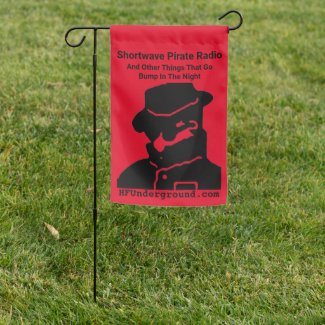This just might be the answer to the overcrowding on the pirate bands.
http://theinstitute.ieee.org/technology-focus/technology-topic/overcoming-spectrum-scarcityOvercoming Spectrum Scarcity
Cognitive radio networks might be one answer
By KATHY PRETZ 13 August 2012
With the exploding popularity of all things wireless, the radio spectrum has become a scarce commodity in many countries. The United States, for example, will run out of radio spectrum by next year, according to the U.S. Federal Communications Commission.
Radio spectrum, which is finite, must accommodate cellphone calls and data traffic that is increasing at an unprecedented rate. Globally, traffic on mobile broadband systems has grown so fast that current levels already exceed predictions made in 2010 for 2020, according to Huawei, a global information and communications technology provider, in China.
Cognitive radio (CR) is one technology under development that could allow spectrum to be used more efficiently. A CR transceiver scans for unused bands and changes its transmission and reception parameters to different frequencies during heavy data loads without interruption. It also can listen for interference on busy channels and calculate a way to reduce it so the channels may be used by more people.
IEEE Vehicular Technology Magazine devoted its June issue to CR, explaining how it works and describing areas that could benefit from its application.
A CHANGING LANDSCAPE
Spectrum is a scarce resource, but measurements reveal that several licensed frequency bands are underutilized most of the time. The key advantage of CR, also known as dynamic spectrum access (DSA), is that it can sense an unused channel and switch to it.
CR is expected to operate in a large portion of the spectrum in the future, according to IEEE Member Gabrield Porto Villardi, Senior Member Giuseppe Thadeu Freitas de Abreu, and Member Hiroshi Harada, the authors of “TV White Space Technology.” In their article, they point out that deployment of CR technology is regulated today only in the vacant channels or white spaces between TV channels. In the United States, for example, those vacant channels lie in the range of 54 to 698 megahertz.
Vacant channels will be released by governments for new services, according to the researchers. With new unlicensed RF devices—called TV band devices or TVBDs—expected to operate in those channels, regulators in Japan, Singapore, the United Kingdom, and the United States have been rewriting their spectrum management policies. The European Conference of Postal and Telecommunications Administrations works with different allocations and has defined TVBD requirements in the 470- to 790-MHz band.
The authors note that the FCC has established two categories for TVBDs: fixed and personal portable devices. Fixed devices may use any of the vacant U.S. TV channels 2, 5 to 36, and 38 to 51, with a power of up to 1 watt (4 watts EIRP—effective isotropic-radiated power). The devices may communicate with each other on any of those channels, and also with so-called personal/portable devices in TV channels 21 through 51. Fixed devices also must be location-aware, query an FCC-mandated database at least daily to retrieve a list of channels usable at their location, and monitor the spectrum locally. They may transmit only within the channels where the database indicates operation is permissible and no signals are detected locally.
Personal/portable stations may operate only on channels 21 to 36 and 38 to 51, with a power of 100 milliwatt EIRP, or down at 40 mW if on a channel adjacent to a TV channel. They may either retrieve a list of permissible channels from an associated fixed station or use a lower output power of 50 mW EIRP and use spectrum sensing alone.
According to the IEEE authors, the Japanese Ministry of Internal Affairs and Communications is considering various uses for its TV white space (TVWS) including advertising, traffic reports, sports and cultural information, and weather forecasts. It also is looking at the white spaces to establish a communications system for disaster areas. The authors include a study of how a TVWS system could have assisted with communications during the 9.0-magnitude earthquake that struck Japan in March 2011.
MORE BUSINESSES
The dynamic spectrum access techniques of CR also have the potential for changing how cellular networks are formed, owned, and operated, according to IEEE members Timothy K. Forde and Linda Doyle and nonmember Justin Tallon in in their article “Dynamic Spectrum Access Networks.” Cellular networks typically are owned and operated by national or transnational companies. But the advent of TVWS systems, the authors say, will let lots of suppliers—not just big carriers—provide cellular service. A provider could be as small as a single base station or access point. The researchers say there could be a host of geographically distributed, independent service providers offering services in uncoordinated, ad hoc ways.
The authors offer ways such providers could form coalitions that would not require much planning or organization. For example, a physical signature placed on each transmission could identify members of a coalition and enable them to devise a handover process so mobile users could move smoothly from one provider to the next. The authors describe how the signature could be used with frequency-varying or dynamic control channels. Embedded in the digital communications signal, the signature could be easily generated, manipulated, detected, and analyzed using simple transceiver architectures. The feature would require little signaling overhead and be detected using short signal observation times. Its detection would facilitate signal acquisition and help establish a communication link.
“The system we proposed is an example of a more decentralized and ad hoc network construction process whereby temporary service can be offered to users without a huge amount of preplanning,” they write.
Once cognitive radio becomes a reality, it’s expected to be used in a wide variety of applications, which several articles in the magazine discuss.



